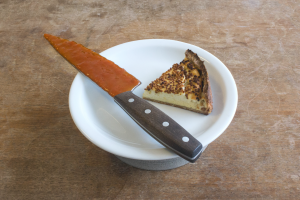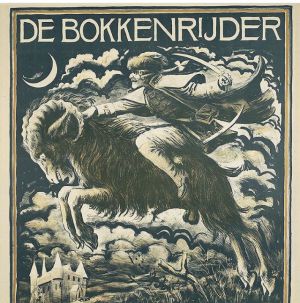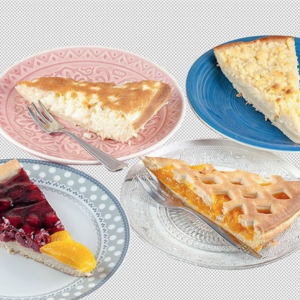Bokkenvlaai: Difference between revisions
No edit summary |
No edit summary |
||
| (17 intermediate revisions by the same user not shown) | |||
| Line 1: | Line 1: | ||
[[File:vlaai.png|thumb|Thumbnailed image|‘Bokkenvlaai’]] | [[File:vlaai.png|thumb|Thumbnailed image|‘Bokkenvlaai’]] | ||
[[File:Bokken.jpeg|thumb|Thumbnailed image| The ’<i>Bokkenrijders</i>’ or ‘buck riders’]] | |||
[[File:Vlaaioriginal.png|thumb|Thumbnailed image| Original limburgse vlaaien]] | |||
The “Bokkenvlaai” was a dish presented to the visitors of fanfare, Amsterdam. | The “Bokkenvlaai” was a dish presented to the visitors of fanfare, Amsterdam, for ‘[[The immersive table (five recipes)]]’. | ||
It consisted of a pie, filled with a creamy goat custard pie and topped with polen. The pie was cut with a knife covered with | It consisted of a pie, filled with a creamy goat custard pie and topped with polen. The pie was cut with a knife covered with | ||
| Line 16: | Line 18: | ||
“Southern Dutch cuisine is famous for its many rich pastries, often filled with cream, custard or fruits, such as the ‘<i>Limburgse Vlaai</i>’. In Dutch, <i>‘vlaai’</i> designates this various flans from the Limburg region, but also vanilla flavored custards in general.<br> | “Southern Dutch cuisine is famous for its many rich pastries, often filled with cream, custard or fruits, such as the ‘<i>Limburgse Vlaai</i>’. In Dutch, <i>‘vlaai’</i> designates this various flans from the Limburg region, but also vanilla flavored custards in general.<br> | ||
Vlaai was originally used in german monasteries as sacrificial bread — a late version of roman ‘<i>libum</i>’. Some sources argue that | Vlaai was originally used in german monasteries as sacrificial bread — a late version of roman ‘<i>libum</i>’. Some sources argue that vlaai was brought later to Nerherlands by <i>Bokkenrijders</i>, in the eighteenth century. This legendary gang of criminals from Limburg named itself after demons who rode on the back of flying goats provided to them by Satan; known as <i>Bokkenrijders</i> (or ‘buck riders’). They were most probably baking vlaai for satanistic ritual purpose, following roman pagan tradition. | ||
This legendary gang of criminals from Limburg named itself after demons who rode on the back of flying goats provided to them by Satan; known as <i>Bokkenrijders</i> (or ‘buck riders’). They were most probably baking | As <i>Bokkenrijders</i> worship the devil and ride bucks, their sacrificial vlaai was made with no other milk than goat milk collected in the province of Limburg. During the gang’s ceremonies, a leader would cut the white flan using a knife covered with red marmelade (made out of rosehips in the winter). The gang members would then gain strength from the rich creamy filling flavoured with rosemary — a plant considered sacred by the romans. | ||
As <i>Bokkenrijders</i> worship the devil and ride bucks, their sacrificial | |||
Goats produce only 2% of the world’s total milk supply and, while goat milk may be a curiosity in a large part of the world, it is common in the Netherlands. Goats have the advantage to be browsing animals: they would eat basically anything and their plant diet is extremely varied. This is the reason why they are often raised with free-ranging methods, encouraging biodiversity around the farm. Besides, their appeal for unwanted plants can be useful: in China, they are traditionally used as “weed-killers” in tea culture. | Goats produce only 2% of the world’s total milk supply and, while goat milk may be a curiosity in a large part of the world, it is common in the Netherlands. Goats have the advantage to be browsing animals: they would eat basically anything and their plant diet is extremely varied. This is the reason why they are often raised with free-ranging methods, encouraging biodiversity around the farm. Besides, their appeal for unwanted plants can be useful: in China, they are traditionally used as “weed-killers” in tea culture. | ||
The “Bokkenvlaai” cooked by [[The Soft Protest Digest|The Soft Protest Digest]] is based on a shortcrust pastry made out of spelt flour crushed at a few kilometers from Amsterdam, by | The “Bokkenvlaai” cooked by [[The Soft Protest Digest:About|The Soft Protest Digest]] is based on a shortcrust pastry made out of spelt flour crushed at a few kilometers from Amsterdam, by Molen De Vlijt. The filling is made with dairy products and eggs from [[Ridammerhoeve Goat Farm|Ridammerhoeve Goat Farm]] in Amsterdamse Bos. In Winter, their goats are mainly fed on fermented grass hay produced on site, mixed with Dutch corn and straw: it allows the farm to produce a large variety of dairy products all year long, made at the doorstep of Amsterdammers. Their herd is composed of highly productive <i>Saanen</i> swiss goats, that are commonly used in intensive farming. Yet, this breed is right on point in North Europe, as it is sensitive to sun. Moreover, their feces are excellent fertilizers which are used all around Amsterdam in farms such as [[Ecologische Boerderij De Boterbloem|Ecologische Boerderij De Boterbloem]], from where the honey perfuming the “Bokkenvlaai” comes from.” | ||
== Recipe == | == Recipe == | ||
| Line 27: | Line 28: | ||
<b>Ingredients</b> | <b>Ingredients</b> | ||
<u> | <u>Dough:</u> | ||
<ul> | <ul> | ||
<li> | <li>150g of white spelt flour</li> | ||
<li>50g of wholegrain oat flour</li> | |||
<li> | <li>100g of goat butter/ghee</li> | ||
<li> | <li>1 egg yolk</li> | ||
<li>Half an eggshell worth of water</li> | |||
<li> | <li>2tbsp of honey</li> | ||
<li> | <li>1 big pinch of salt</li> | ||
<li> | |||
<li> | |||
</ul> | </ul> | ||
<u> | |||
<u>Filling:</u> | |||
<ul> | |||
<li>500ml of milk (goat)</li> | |||
<li>50g of young geitenkaas (goat cheese)</li> | |||
<li>40g of white spelt flour</li> | |||
<li>20g of potato starch</li> | |||
<li>4 egg yolks</li> | |||
<li>2 egg whites</li> | |||
<li>30g of rosemary</li> | |||
<li>3tbsp of honey</li> | |||
</ul> | |||
<u>Crumble:</u> | |||
<ul> | <ul> | ||
<li> | <li>2tbsp of pollen</li> | ||
</ul> | </ul> | ||
<u> | <u>Jam:</u> | ||
<ul> | <ul> | ||
<li> | <li>200g of dried rosehip berries</li> | ||
<li> | <li>5tbsp of honey</li> | ||
</ul> | </ul> | ||
<b>Preparation</b> | <b>Preparation</b> | ||
<u> | <u>Dough:</u> | ||
1. Mix the 2 flours with the salt in a mixing bowl.<br> | |||
2. Mix in the diced cold butter/ghee and break with the tip of your fingers until it turns into a coarse sand like texture.<br> | |||
3. Make a well in the center and pour in the egg yolk, the water and the honey.<br> | |||
4. Mix and form a ball, being careful to not overwork the dough.<br> | |||
5. Leave aside in the fridge. | |||
<u>Pastry cream:</u> | |||
1. Warm the milk, honey, rosemary and cheese to a boil and stir, lower the heat and simmer for 5min.<br> | |||
2. Whip the egg yolks, flour and potato starch until it turns pale yellow.<br> | |||
3. Sieve the milk and leave to cool.<br> | |||
4. Pour in a few table spoons of the lukewarm milk in the egg yolk mixture and whip vigorously until smooth.<br> | |||
5. Incorporate to the rest of the milk, continuously stirring with a whisk, slowly increase the heat and cook until it reaches a custard consistency (keep in mind that when cooled, the cream will thicken even more).<br> | |||
6. Leave to cool to room temperature, covering the surface with clean film to prevent the formation of a dry skin. | |||
<u>Soufflé cream:</u> | |||
1. | 1. Whip the egg whites to stiff picks. Carefully fold in the egg whites in 200g of the custard. | ||
<u> | <u>Jam:</u> | ||
1. | 1.Rehydrate the rose hip berries in 100ml of simmering water, stir in the honey.<br> | ||
2. | 2. Reduce on low heat for about 30min or until it reaches a jam consistency. | ||
< | <b>How to build the vlaai:</b> | ||
1. | 1. Finely roll the dough and line in a 20cm wide pie tin. Trim the edges.<br> | ||
2. | 2. Using a piping bag, fill in the pie with the pastry cream. Repeat the process with the soufflé cream before evenly scattering the pollen on top.<br> | ||
3. | 3. Bake in a preheated 200°c oven for 15min, and for an additional 10min at 170°c.<br> | ||
4. | 4. Cut in equal size slices with a large knife covered with rosehip jam. Serve warm or cold. | ||
== Products == | == Products == | ||
<ul> | <ul> | ||
<li>[[ Ekoplaza ]] / oat | <li>[[ Ekoplaza ]] / dry rosehips or <i>rozenbottel</i> (Piramide, NL) / oat flour (Joannusmolen, NL) / eggs (Ekoplaza, NL)) / (Molen De Zaandhas, NL)</li> | ||
<li>[[ Ecologische Boerderij De Boterbloem ]] / | <li>[[ Ecologische Boerderij De Boterbloem ]] / flower honey (NL)</li> | ||
<li>[[ Ridammerhoeve Goat Farm ]] / goat milk / | <li>[[ Ridammerhoeve Goat Farm ]] young goat cheese / goat milk / butter / fresh eggs (Amsterdam, NL)</li> | ||
<li>[[ Molen De Vriendschap ]] / oat whole grain flour (Germany)</li> | <li>[[ Molen De Vriendschap ]] / oat whole grain flour (Germany)</li> | ||
<li>[ | <li>Noordermarkt (Amsterdam biologische markt) / fresh rosemary (Ayme Philippe, Mas de Florent, 13150 Tarascon, [http://laboiteaherbes.com/ laboiteaherbes.com], FR) / honey & pollen (Honing van Koning, Vinkeveen, NL)</li> | ||
</ul> | </ul> | ||
== | == Resilience of the dish and its products: == | ||
Click to zoom in on the receipts 🔍 | |||
<gallery mode="traditional" heights=400px> | |||
File:Vlaaireceipt.jpg|✎ ‘Bokkenvlaai’ | |||
File:Oatmeal.jpg|✎ Oat flour | |||
File:Eggsreceipt.jpg|✎ Fresh eggs | |||
File:Honey.jpg|✎ Flower honey | |||
File:Goatmilkcheesebutter.jpg|✎ Young goat cheese / goat milk / butter | |||
File:Pollen.jpg|✎ Pollen | |||
</gallery> | |||
Latest revision as of 11:12, 8 March 2022
The “Bokkenvlaai” was a dish presented to the visitors of fanfare, Amsterdam, for ‘The immersive table (five recipes)’.
It consisted of a pie, filled with a creamy goat custard pie and topped with polen. The pie was cut with a knife covered with rosehip jam.
The dish was shown and accompanied by a podcast laying out the reasons why the dish may be both environmentally and culturally resilient in the North Holland region.
To listen to the podcast:
The podcast can be found on the podcast app (by researching “The Soft Protest Digest”/Bokkenvlaai) or by following this link to our Soundcloud.
Transcript of the podcast of the “Bokkenvlaai”
“Southern Dutch cuisine is famous for its many rich pastries, often filled with cream, custard or fruits, such as the ‘Limburgse Vlaai’. In Dutch, ‘vlaai’ designates this various flans from the Limburg region, but also vanilla flavored custards in general.
Vlaai was originally used in german monasteries as sacrificial bread — a late version of roman ‘libum’. Some sources argue that vlaai was brought later to Nerherlands by Bokkenrijders, in the eighteenth century. This legendary gang of criminals from Limburg named itself after demons who rode on the back of flying goats provided to them by Satan; known as Bokkenrijders (or ‘buck riders’). They were most probably baking vlaai for satanistic ritual purpose, following roman pagan tradition.
As Bokkenrijders worship the devil and ride bucks, their sacrificial vlaai was made with no other milk than goat milk collected in the province of Limburg. During the gang’s ceremonies, a leader would cut the white flan using a knife covered with red marmelade (made out of rosehips in the winter). The gang members would then gain strength from the rich creamy filling flavoured with rosemary — a plant considered sacred by the romans.
Goats produce only 2% of the world’s total milk supply and, while goat milk may be a curiosity in a large part of the world, it is common in the Netherlands. Goats have the advantage to be browsing animals: they would eat basically anything and their plant diet is extremely varied. This is the reason why they are often raised with free-ranging methods, encouraging biodiversity around the farm. Besides, their appeal for unwanted plants can be useful: in China, they are traditionally used as “weed-killers” in tea culture. The “Bokkenvlaai” cooked by The Soft Protest Digest is based on a shortcrust pastry made out of spelt flour crushed at a few kilometers from Amsterdam, by Molen De Vlijt. The filling is made with dairy products and eggs from Ridammerhoeve Goat Farm in Amsterdamse Bos. In Winter, their goats are mainly fed on fermented grass hay produced on site, mixed with Dutch corn and straw: it allows the farm to produce a large variety of dairy products all year long, made at the doorstep of Amsterdammers. Their herd is composed of highly productive Saanen swiss goats, that are commonly used in intensive farming. Yet, this breed is right on point in North Europe, as it is sensitive to sun. Moreover, their feces are excellent fertilizers which are used all around Amsterdam in farms such as Ecologische Boerderij De Boterbloem, from where the honey perfuming the “Bokkenvlaai” comes from.”
Recipe
Ingredients
Dough:
- 150g of white spelt flour
- 50g of wholegrain oat flour
- 100g of goat butter/ghee
- 1 egg yolk
- Half an eggshell worth of water
- 2tbsp of honey
- 1 big pinch of salt
Filling:
- 500ml of milk (goat)
- 50g of young geitenkaas (goat cheese)
- 40g of white spelt flour
- 20g of potato starch
- 4 egg yolks
- 2 egg whites
- 30g of rosemary
- 3tbsp of honey
Crumble:
- 2tbsp of pollen
Jam:
- 200g of dried rosehip berries
- 5tbsp of honey
Preparation
Dough:
1. Mix the 2 flours with the salt in a mixing bowl.
2. Mix in the diced cold butter/ghee and break with the tip of your fingers until it turns into a coarse sand like texture.
3. Make a well in the center and pour in the egg yolk, the water and the honey.
4. Mix and form a ball, being careful to not overwork the dough.
5. Leave aside in the fridge.
Pastry cream:
1. Warm the milk, honey, rosemary and cheese to a boil and stir, lower the heat and simmer for 5min.
2. Whip the egg yolks, flour and potato starch until it turns pale yellow.
3. Sieve the milk and leave to cool.
4. Pour in a few table spoons of the lukewarm milk in the egg yolk mixture and whip vigorously until smooth.
5. Incorporate to the rest of the milk, continuously stirring with a whisk, slowly increase the heat and cook until it reaches a custard consistency (keep in mind that when cooled, the cream will thicken even more).
6. Leave to cool to room temperature, covering the surface with clean film to prevent the formation of a dry skin.
Soufflé cream:
1. Whip the egg whites to stiff picks. Carefully fold in the egg whites in 200g of the custard.
Jam:
1.Rehydrate the rose hip berries in 100ml of simmering water, stir in the honey.
2. Reduce on low heat for about 30min or until it reaches a jam consistency.
How to build the vlaai:
1. Finely roll the dough and line in a 20cm wide pie tin. Trim the edges.
2. Using a piping bag, fill in the pie with the pastry cream. Repeat the process with the soufflé cream before evenly scattering the pollen on top.
3. Bake in a preheated 200°c oven for 15min, and for an additional 10min at 170°c.
4. Cut in equal size slices with a large knife covered with rosehip jam. Serve warm or cold.
Products
- Ekoplaza / dry rosehips or rozenbottel (Piramide, NL) / oat flour (Joannusmolen, NL) / eggs (Ekoplaza, NL)) / (Molen De Zaandhas, NL)
- Ecologische Boerderij De Boterbloem / flower honey (NL)
- Ridammerhoeve Goat Farm young goat cheese / goat milk / butter / fresh eggs (Amsterdam, NL)
- Molen De Vriendschap / oat whole grain flour (Germany)
- Noordermarkt (Amsterdam biologische markt) / fresh rosemary (Ayme Philippe, Mas de Florent, 13150 Tarascon, laboiteaherbes.com, FR) / honey & pollen (Honing van Koning, Vinkeveen, NL)
Resilience of the dish and its products:
Click to zoom in on the receipts 🔍








